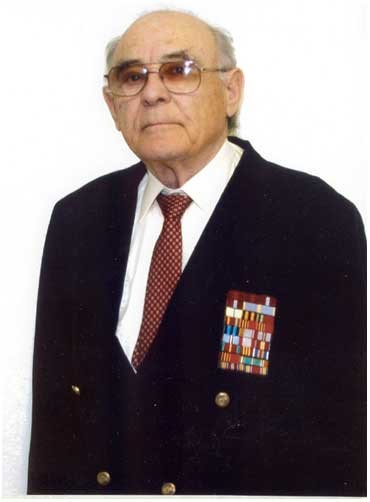Efim Stoliarskii was born in 1923 in a village between Zhitomir and Kiev, in northern Ukraine and then lived in Vinnitsa (also in Ukraine). After graduating from high school in Vinnitsa, he entered a teachers' institute, where he studied biology. In 1941 he was drafted into the Red Army and sent to the Odessa Higher Artillery Command School. There he learned of the German attack on the Soviet Union in June 1941. Like other cadets, he volunteered to take part in the defense of Odessa. However, when the Soviet command decided to evacuate the school with all its cadets, in August 1941, his Command School was transferred to the Urals. The first train that was transporting the school was bombed by the Germans, and all its cadets were killed. Stoliarsii was in the second train.
Lieutenant Stoliarskii was drafted into the Red Army for the second time in June 1942 in Chkalov (now Orenburg) in the Urals in Russia. He was assigned to a light artillery regiment that was operating in the northern sector of the Soviet-German Front, Volkhov Front, and then Leningrad Front, etc. He took part in the breaking of the siege of Leningrad in January 1943. Subsequently he fought south of Leningrad and in Estonia, Latvia, and Eastern Prussia.
Light artillery was used by the Red Army mainly to fire at the enemy at short range, sometimes from one hundred meters or less. Serving in such a unit was dangerous, possibly even more dangerous, than serving in the infantry. However, Stoliarskii was wounded for the first time only in 1943. After a long recovery in hospital, he was assigned to a different artillery regiment.
In January 1944, during the fighting for Novgorod, south of Leningrad, Stoliarskii's men broke through the German defense line in its northernmost sector. In order to exploit this success, he ordered cannons to be placed on the regiment's jeeps, which then proceeded at full speed to break through to Novgorod. With this very dangerous operation, Stoliarskii not only prevented the enemy from mining the only bridge in this sector, but also penetrated to the city center. The following Soviet offensive in this sector rescued Stoliarsky's unit. After the liberation of Novgorod he was awarded the Order of the Patriotic War, 1st Class.
An article on Efim Stoliarsky was prepared for the Moscow Yiddish newspaper Eynikayt in September 1944 by M. Edel.
After the war Stoliarsky continued to serve as an artillery officer. In 1968 he retired and settled in Bălţi, Moldova, where he worked at the meat processing plant as its deputy director for commercial matters. He took part in fund-raising in the late 1980s to establish in this town a monument for the victims of the Holocaust. In 1991 Stoliarskii moved to the USA with all of his family, settling in Los Angeles. In 1992 he joined the Los Angeles Association of Veterans of World War II from the former Soviet Union. In 1996 he became president of the Association.
From the article on Efim Stoliarskii prepared for Eynikayt in 1944
"Stoliarskii opened a pack of [American] cigarettes, and we read a Russian message on a light blue card that was inserted into the pack: 'Our fraternal greetings from 25,000 American workers, members of the International Ladies' Garment Workers' Union to you, Russian warriors, in honor of your courageous and valiant struggle against the enemy of humanity and civilization – against Hitler and Fascism.'
'A good gift!' Stoliarsky said while lighting a cigarette. – Our soldiers appreciate the attention of their American friends. You have to write about this.
'I promised that I would…
– […] My mother is an old woman [he continued], she is working in the rear side. I have never written to her that I am serving with the short- range artillery, which shoots at the German bunkers from the distance of one hundred meters. She wouldn't believe me. She wouldn't believe that when he shouts the order "Fire!," her quiet, shy boy Fima, can clearly make out the terrified faces of the Germans. […]
'Are there other Jews in your battery? ' I asked.
'In my battery there is only one, Lazar Shneider, the driver of a Willys jeep. But in the third battery there are several Jews, and all of them are former students of Kharkov University.[…] The first cannon is opeated by students and the second one -- by former kolkhoz peasants, who together have a total of ten years of education. Yet the two gun-crews cooperate very well!'







